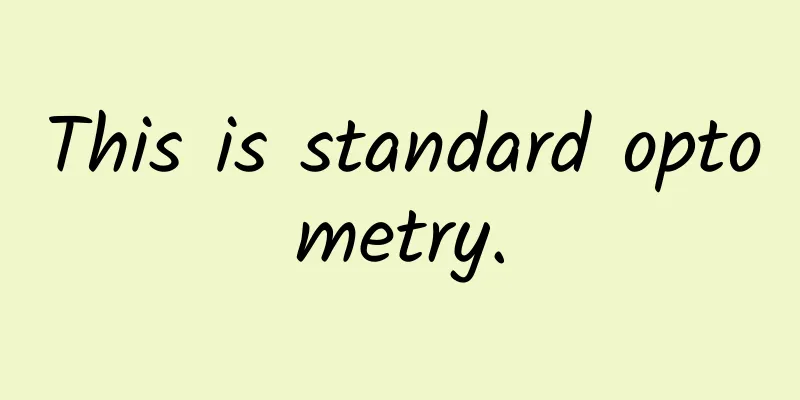This is standard optometry.

|
Recently many parents have been talking about this: "I took my child to three places for vision tests, but the results were different every time... and I don't know which one is more accurate?" Regarding this issue, let's learn about what standard optometry is! 1. Medical consultation Before the eye examination begins, the optometrist will have a brief understanding of the patient's vision and correction status, including the patient's history of wearing glasses, history of old glasses, whether there are any eye diseases, age and occupation, work environment, etc. 2. Vision test Use an eye chart to check the patient's naked eye vision. For patients who already wear glasses, also check the corrected vision of the original glasses. 3. Computer optometry (about 30s) Check the refraction, astigmatism and astigmatism axis of both eyes with retinoscopy or computer ophthalmometer. If necessary, perform mydriasis optometry on the patient (especially for children). 4. Adjustment of comprehensive ophthalmometer (10-20min) The most corrected best vision is accurately measured by the comprehensive ophthalmometer, and the red-green balance and binocular balance are performed at the same time, and the diopter is adjusted. During the adjustment process, the optometrist will communicate with the patient repeatedly based on the patient's actual feelings and direct reactions, and continuously adjust the patient's myopia, astigmatism, and astigmatism axis. 5. Visual function examination: 1. Check the dominant eye and determine whether it is adequately corrected; 2. Check eye position to see if there is any internal or external strabismus, and adjust the diopter accordingly; 3. Check binocular vision, closing function and stereoscopic vision; 4. Test the near vision to check if the child has difficulty reading. If the child is over-corrected for myopia and has obvious symptoms such as difficulty reading, small characters, and dizziness, it is necessary to reduce the degree of the glasses. 5. Color vision test: use a color vision test chart to check whether the patient has color sensitivity or color deficiency. 6. Try on (trying on is very important, only your eyes can tell whether it fits you well): Try on the glasses and determine the final prescription, select the appropriate lenses and insert them into the trial frames, and let the patient try them on for about 15 minutes. If the vision reaches the best state and there is no discomfort, the prescription can be filled. Do you know the standard optometry process now? Our eye examination results are related to our recent rest status, the experience and professional level of the optometrist, the eye examination process, etc., so it is very likely that the test results in different places will be slightly different. Suzhou Children's Vision Health Science Museum Children's Vision Health Science Popularization Base in China Focus on children's vision health and protect your eyesight |
<<: These two bad habits can easily lead to serious illness, so don't take it lightly!
Recommend
Can I drink honey water when I have my period?
Many of our daily necessities are added with pure...
Why can’t I get pregnant after having my IUD removed?
The continuous development of society and the pro...
Can I do my hair during menstruation?
Compared with boys, women care more about their h...
What causes headaches and dizziness during pregnancy?
What causes dizziness and headaches during pregna...
What is the matter with the hardness in the breast?
Because breast cancer has become a serious proble...
Guidelines for the management of soft tissue contusions following falls
1. What is soft tissue contusion? Soft tissue con...
High maternal heart rate
After you get pregnant, you can’t take many thing...
What are the symptoms of blocked milk ducts?
Blocked milk ducts are a common condition during ...
When does a girl get her period?
Girls will have their periods when they reach a c...
Have you heard of Sinus Tarsi Syndrome?
This is the 3645th article of Da Yi Xiao Hu There...
How to best treat poor ovarian function
As a woman, no matter what age you are, you shoul...
Why do lily buds turn yellow? How to remedy the yellowing of lily buds?
Lily is very common in life. It is loved by flowe...
Single women are thinking about these things
"In this society that advocates youth, makin...
What are the harms to the body after cervical removal?
Many women are easily troubled by some gynecologi...
What causes women's feet to smell sour?
When it comes to smelly feet, the first thing tha...









